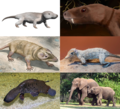Cynodontia (redirect from Cynodonts)
Mammals are cynodonts, as are their extinct ancestors and close relatives (Mammaliaformes), having evolved from advanced probainognathian cynodonts during...
26 KB (2,103 words) - 22:55, 4 October 2024
remaining non-mammalian cynodonts were small, such as Tritylodon. No cynodont grew larger than a cat. Most Jurassic and Cretaceous cynodonts were herbivorous...
57 KB (5,746 words) - 21:05, 25 September 2024
Luangwa is an extinct genus of traversodontid cynodonts. The species Luangwa drysdalli was discovered 1963 in the valley of the Luangwa river in Zambia...
3 KB (146 words) - 22:49, 1 March 2024
pterosaurs, etc.) during the Middle Triassic. The therapsids include the cynodonts, the group that gave rise to mammals (Mammaliaformes) in the Late Triassic...
30 KB (2,935 words) - 20:50, 28 September 2024
Evolution of mammals (section Cynodonts)
million years ago. The cynodonts, a theriodont group that also arose in the late Permian, include the ancestors of all mammals. Cynodonts' mammal-like features...
141 KB (15,179 words) - 04:35, 13 August 2024
Epicynodontia (category Cynodonts)
Epicynodontia is a clade of cynodont therapsids that includes most cynodonts, such as galesaurids, thrinaxodontids, and Eucynodontia (including mammals)...
4 KB (145 words) - 17:48, 30 September 2024
primarily Carnian in age (Late Triassic), and is notable for its fossils of cynodonts, "rauisuchian" pseudosuchians, and early dinosaurs and other dinosauromorphs...
63 KB (4,069 words) - 03:58, 8 October 2024
Guttigomphus (category Prehistoric cynodont genera)
December 2022). "Guttigomphus avilionis gen. et sp. nov., a trirachodontid cynodont from the upper Cynognathus Assemblage Zone, Burgersdorp Formation of South...
1 KB (79 words) - 13:25, 9 October 2024
ancestors, drove the remaining larger cynodonts into extinction, leaving only the smaller forms. The surviving cynodonts could only succeed in niches with...
11 KB (1,069 words) - 01:01, 18 June 2024
brief surge in diversification in the Triassic, with dicynodonts and cynodonts quickly becoming dominant, but they declined throughout the period with...
71 KB (7,717 words) - 19:20, 13 October 2024
and modern frogs, salamanders & lizards. Mammaliaformes, one of the few cynodont lineages to survive the end of the Triassic, continued to diversify throughout...
233 KB (25,196 words) - 19:13, 13 October 2024
therapsids became dominant during the Guadalupian. Mammals originated from cynodonts, an advanced group of therapsids, during the Late Triassic to Early Jurassic...
222 KB (23,103 words) - 19:04, 29 September 2024
proposed that cynodonts may have evolved from therocephalians and so that therocephalians as recognised are paraphyletic in relation to cynodonts. The fossils...
31 KB (2,981 words) - 23:53, 1 October 2024
Thrinaxodon is an extinct genus of cynodonts, including the species T. liorhinus which lived in what are now South Africa and Antarctica during the Early...
29 KB (3,709 words) - 18:05, 30 September 2024
Hyneria, Pederpes, Dinocephalian, Gorgonops, Diictodon (fossil), and Cynodont. This episode centres on the Permian to Tertiary periods, showing numerous...
5 KB (451 words) - 18:39, 22 May 2024
sprawled outwards in a reptilian fashion, but recent studies suggest cynodonts typically held their front legs in a posture between these two extremes...
13 KB (1,306 words) - 01:38, 11 October 2024
Prozostrodontia is a clade of cynodonts including mammaliaforms and their closest relatives such as Tritheledontidae and Tritylodontidae. It was erected...
7 KB (382 words) - 13:03, 12 May 2024
Probainognathus meaning “progressive jaw” is an extinct genus of cynodonts that lived around 235 to 221.5 million years ago, during the Late Triassic...
19 KB (1,837 words) - 11:31, 26 July 2024
appear during the Middle Permian and which includes therocephalians and cynodonts, this latter group including mammals and related forms. With the dicynodonts...
4 KB (450 words) - 23:55, 1 October 2024
leptictidans and cimolestans) mammals appear while the last non-mammalian cynodonts die out. First terrestrial crabs. Many snails become terrestrial. Further...
174 KB (9,789 words) - 10:34, 9 October 2024
Brasilodon ("tooth from Brazil") is an extinct genus of small, mammal-like cynodonts that lived in what is now Brazil during the Norian age of the Late Triassic...
47 KB (5,758 words) - 08:25, 26 September 2024
has been put forward as the most likely explanation why this therapsid cynodont Thrinaxodon liorhinus shared its burrow with a temnospondyl amphibian,...
15 KB (1,594 words) - 18:29, 24 May 2024
Eucynodontia (category Cynodont stubs)
Eucynodontia ("true dog teeth") is a clade of cynodont therapsids including mammals and most non-mammalian cynodonts. The oldest eucynodonts are known from the...
6 KB (279 words) - 18:03, 30 September 2024
Chiniquodon is an extinct genus of carnivorous cynodonts, which lived during the Late Triassic (Carnian) in South America (Argentina and Brazil) and Africa...
7 KB (636 words) - 17:31, 13 July 2024
Procynosuchus (category Cynodonts)
crocodile") is an extinct genus of cynodonts from the Late Permian. It is considered to be one of the earliest and most basal cynodonts. It was 60 cm (2 ft) long...
6 KB (477 words) - 01:37, 11 October 2024
Panchetocynodon P. damodarensis A cynodont of uncertain affinity. Thrinaxodon T. bengalensis A thrinaxodontid cynodont. Considered a nomen nudum. The specimen...
7 KB (316 words) - 17:22, 17 August 2024
Buckbeak is featured in Harry Potter and the Prisoner of Azkaban. Hodag – A cynodont-like creature with horns resembling a cross between a frog and a dog. Horklump...
30 KB (3,678 words) - 22:06, 8 October 2024
secretions may have been nutrition and immunological protection. Tritylodontid cynodonts seem to have displayed lactation, based on their dental replacement patterns...
150 KB (15,550 words) - 22:34, 30 September 2024
the first appearance of the Archosauriformes during the latest Permian. Cynodonts, the group of therapsids ancestral to modern mammals, first appeared and...
115 KB (11,882 words) - 19:46, 27 September 2024
Ruta, Botha-Brink, Mitchell and Benton (2013) showing one hypothesis of cynodont relationships: Cladogram from Stefanello et al. (2023): Evolution of mammals...
8 KB (317 words) - 19:53, 30 September 2024


























